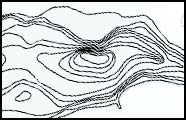All About Bass Fishing - Guide To Deep Structure Tactics
By Rick Seaman and Dan Westfall
 Structure is the 3-dimendional variations in the contour of the lake bottom. Bass use humps, points, creek channels, flats and drop offs as holding spots and migration routes. The key to structure fishing is to identify these structures that are present at the depth the bass are holding. When the bass move out and down, it’s time to look for the structure that will hold them. Structure with wide depth ranges and cover are likely to be the best areas.
Structure is the 3-dimendional variations in the contour of the lake bottom. Bass use humps, points, creek channels, flats and drop offs as holding spots and migration routes. The key to structure fishing is to identify these structures that are present at the depth the bass are holding. When the bass move out and down, it’s time to look for the structure that will hold them. Structure with wide depth ranges and cover are likely to be the best areas.
3 Most Important Factors About Fishing Deep Structure
- The best deep structure is near mid-depth feeding areas and next to deep water.
- Deep structure with cover is likely to hold more bass.
- Seek out deep structure near major creek channels when possible.
3 Most Effective Fishing Methods & Lures
- Heavy weighted artificial worms fished Texas style, Carolina rigged or drop shot on or near cover.
- Heavy jigs - one-half ounce to one ounce, fished on and near the bottom.
- Slab spoons vertical fished in and around drop offs and cover.
In deep water, seek out structure to locate bass
 Topographical maps are the ideal place to begin locating cover. GPS units with mapping can also help you locate these pieces of structure. You can review maps before leaving on your trip, and locate structure near shallow feeding areas nearby mid-depth holding areas. Once you arrive at the lake you can move from spot to spot to determine which spots are holding bass.
Topographical maps are the ideal place to begin locating cover. GPS units with mapping can also help you locate these pieces of structure. You can review maps before leaving on your trip, and locate structure near shallow feeding areas nearby mid-depth holding areas. Once you arrive at the lake you can move from spot to spot to determine which spots are holding bass.
If you do not have access to maps or GPS you can find these structures the old fashion way. Begin by selecting a shallow feeding area and try to determine where the bass go when they leave this area. They typically follow a point, creek channel or drop off when they move from shallow to deeper water. Use a depth finder to meter the surrounding area and identify where the most dramatic depth changes occur. Concentrate on these areas and see if you can identify the depth where the bass are holding.
If schools of baitfish are nearby, it will generally enhance your opportunity for success on structure. The ideal situation is to find a great piece of structure, with drop offs to deeper water, with cover on top of the structure and schools of bait hanging around and above the structure.
When bass are present on structure, they may be holding, feeding or migrating. Active bass readily let you know they are present. They will appear on the fish finder and typically will go after lures presented to them. For these active bass, a slab spoon or heavy jig is a good approach. You can work the area quickly and cover more water during this active period.
If the bass are simply holding on a piece of structure, they may not be as easy to see on fish finders and will be more difficult to catch. These bass tend to hold tight to cover, bottom and drop offs. To catch these bass you must trigger their reaction instincts with an active lure like a spoon or fish slow with smaller baits which tease the bass into biting.
Migrating bass move along a given piece of structure, or at times, move from one piece of structure to another. If you locate a school of migrating bass it is important to determine their direction and move with them. Or, if it’s a migration route, you can sit and wait for the next group to pass by.
Once you identify the activity level of the bass, you can select a lure that gets the most action. Start by vertical jigging with a ¾- ounce or 1-ounce, jigging spoon because you can cover lots of water and catch active or inactive bass. Fish the spoon fast and then slowly before changing to the next option, which would be a jig. Begin the search with a 3/4-ounce or 1-ounce jig fished quickly, but staying in contact with the bottom after each lift. Then drop down in jig size to see if the bass are present, but not aggressive.
If the spoons and jigs are not getting action, and you believe the bass are there, switch to a drop shot or Carolina rig worm and fish the same area more slowly.
For the most part, when you locate a piece of structure which holds bass, you can count on returning to this spot in the future to find bass there again and again during appropriate seasons.
AA Bass Fishing Knowledge Base
- Bass Fishing Overview
- Life Cycle Of Bass
- Seasonal Bass Migration
- Bass Migration - Mid to Late Winter
- Bass Migration - Spring
- Bass Migration - Early Summer
- Bass Migration - Late Summer
- Bass Migration - Fall
- Bass Migration - Early Winter
- Fishing For Bass
- It's Now WHAT You Throw, It's WHERE
- Research The Fishery Before You Go
- Review Contour Maps
- Types Of Cover Used By Bass
- Bass Fishing In Grass Beds
- Bass Fishing In Wood & Timber
- Bass Fishing In Brush & Vegetation
- Establishing Patterns
- Learn To Recognize Bites
- Review Lunar Tables
- Choose The Right Lures
- Find Bass Based On Conditions
- Conditions - Fold Fronts
- Conditions - Wind
- Conditions - Cloudy Days
- Conditions - Fishing In The Rain
- Conditions - Water Clarity
- Conditions - Rising Water
- Conditions - Falling Water
- Conditions - Fishing At Night
- Equipment & Tackle
- Equipment - Fishing Rods
- Equipment - Fishing Reels
- Equipment - Fishing Line
- Equipment - Fishing Lures
- Fishing With Live Bait
- Shallow Water Techniques, 0 -10'
- Shallow Fishing - Spinnerbaits
- Shallow Fishing - Crankbaits
- Shallow Fishing - Top Water
- Shallow Fishing - Pitching & Flipping
- Shallow Fishing - Artificial Worms
- Shallow Fishing - Jigs
- Shallow Fishing - Flukes
- Shallow Fishing - Stick Worms
- Shallow Fishing - Swimbaits
- Fishing Mid Range Depths, 10' - 25'
- Mid Depth - Spinnerbaits
- Mid Depth - Deep Diving Crankbaits
- Mid Depth - Artificial Worms
- Mid Depth - Jigs
- Mid Depth - Swimbaits
- Fishing Deep Water & Structure
- Fishing Deep Water - Jigs
- Fishing Deep Water - Jigging Spoons
- Fishing Deep Water - Artificial Worms
- Planning Your Attack
- Bass Fishing Questions & Answers
- Conservation - Protect The Fishery
Bass information by state
101624
Fishing Information



